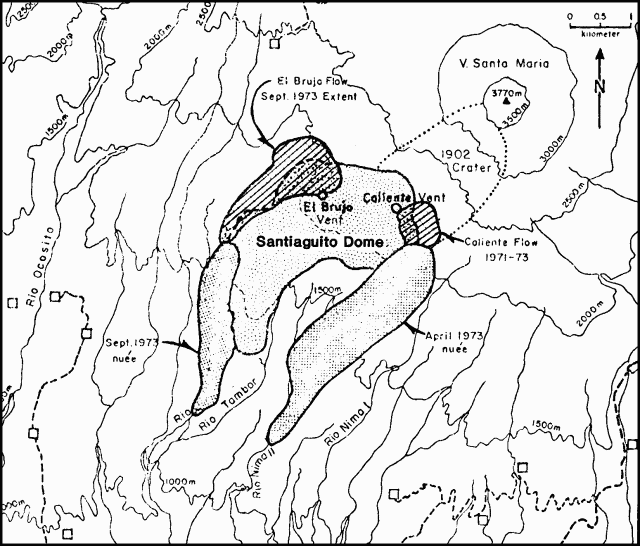Report on Santa Maria (Guatemala) — November 1978
Scientific Event Alert Network Bulletin, vol. 3, no. 11 (November 1978)
Managing Editor: David Squires.
Santa Maria (Guatemala) Moderate explosions every 1.5-2 hours
Please cite this report as:
Global Volcanism Program, 1978. Report on Santa Maria (Guatemala) (Squires, D., ed.). Scientific Event Alert Network Bulletin, 3:11. Smithsonian Institution. https://doi.org/10.5479/si.GVP.SEAN197811-342030
Santa Maria
Guatemala
14.757°N, 91.552°W; summit elev. 3745 m
All times are local (unless otherwise noted)
A joint expedition of geology students and professors from Dartmouth College and Michigan Tech. Univ. visited Santiaguito in late November. The following report, by William I. Rose, Jr. and Richard Stoiber, is based on their observations on 22 and 23 November.
"Volcanic activity at Santiaguito was concentrated at Caliente Vent (figure 1), with no activity occurring at El Brujo. Steam and ash explosions occurred at regular intervals of 1.5-2 hours. They lasted 1-2 minutes and usually produced an ash cloud approximately 1 km above the vent. Blocks and bombs, seen to be incandescent at night, were thrown 200 m from the vent. This is very similar to Caliente Vent activity reported several times since 1975.
 |
Figure 1. Map of Santiaguito and vicinity showing areas devastated by nuées ardentes in April and September 1973. Squares represent inhabited areas. From Rose, Pearson, and Bonis, 1976/7. |
"Lava extruded in 1976 from Caliente Vent and material washed by torrential rains from the walls of Santa María have helped to produce a flat floor in the 1902 crater, and easy access to the E flanks of Santiaguito for the first time in many years. Observations of Caliente Vent from the E show that it is now surrounded by a 50-m-high cone of ash, blocks, and bombs."
The Dartmouth-Michigan Tech. team could see burned vegetation extending at least 2 km down the valley of the Río Nimá II (on the S flank), indicating that ashflows have descended from the dome since the rainy season ended in October.
Reference. Rose, W. Jr., Pearson, T., and Bonis, S., 1976/77, Nuée ardente eruption from the foot of a dacite lava flow, Santiaguito Volcano, Guatemala: Bull Volc, v. 40, no. 1, p. 23-38.
Geological Summary. Symmetrical, forest-covered Santa María volcano is part of a chain of large stratovolcanoes that rise above the Pacific coastal plain of Guatemala. The sharp-topped, conical profile is cut on the SW flank by a 1.5-km-wide crater. The oval-shaped crater extends from just below the summit to the lower flank, and was formed during a catastrophic eruption in 1902. The renowned Plinian eruption of 1902 that devastated much of SW Guatemala followed a long repose period after construction of the large basaltic andesite stratovolcano. The massive dacitic Santiaguito lava-dome complex has been growing at the base of the 1902 crater since 1922. Compound dome growth at Santiaguito has occurred episodically from four vents, with activity progressing E towards the most recent, Caliente. Dome growth has been accompanied by almost continuous minor explosions, with periodic lava extrusion, larger explosions, pyroclastic flows, and lahars.
Information Contacts: W. Rose, Jr., Michigan Tech. Univ.

